Scientific Advertising is not just a book, it’s a bible for copywriting enthusiasts, an ageless classic that has stood the test of time.
It’s been recommended time and time again as the best foundation for learning the principles of direct marketing by industry legends such as Dan Kennedy and Gary Halbert. Even David Ogilvy, the groundbreaking advertising executive known as “The Father of Advertising,” said this:
“Nobody should be allowed to have anything to do with advertising until he has read this book seven times. It changed the course of my life.”
—David Ogilvy
But what is it about “Scientific Advertising” that has attracted so much acclaim? What timeless secrets does it hold that continue to guide the best minds in marketing even today? The answer lies in understanding its author, Claude Hopkins, and his unique approach to advertising.
Who was Claude Hopkins?
Claude Hopkins (1866–1932) was no ordinary ad-man; he was a pioneer, popularizing many strategies that we now take for granted, like using coupons to trace the sales of ad campaigns. By the time he wrote “Scientific Advertising,” he had over 35 years of experience!
Hopkins’ career culminated in his becoming the President of Lord and Thomas, the largest advertising agency at the time. For that position, he was offered an unprecedented salary of $185,000 in 1908, which would be over $5.3 million dollars today! Can you imagine getting paid that much to create ads?!
(Just a note: since this book was written in the 1920s, it does include some old stereotypes. For example, the word “he” is always used when talking about the person writing advertising. We’ll need to look past that.)
🧪 1. Test Your Ads: Measure the sales from each advertising campaign—that’s the only way to become a more successful marketer
What is the most popular view of how advertising is created? I think that people believe it’s all about creativity. The ad writer sits in an office, perhaps smoking a cigar or sipping a whisky. They ponder and wait for inspiration to strike, then suddenly… EUREKA! They’re hit with a new idea that will revolutionize the sales of Coca Cola, Apple, or whatever.
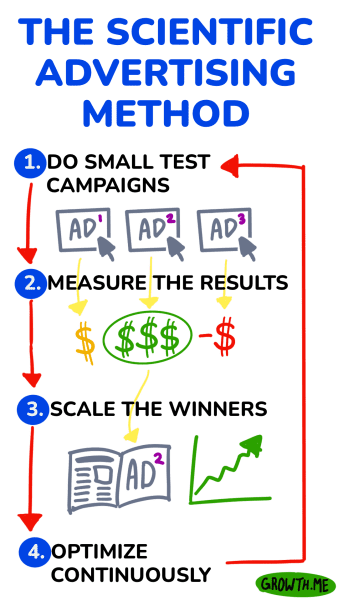
But Claude Hopkins’ approach to advertising was much different, almost scientific. His advertisements were all individual experiments, with the goal being to find out what resonates with customers. Not through intuition, but using thousands of repeated tests.
In Hopkins’ ad agencies, decisions were made not by arguments around a table, but by putting the ideas to the test. The ultimate authority was always the customer, what they responded to. And when you do test, Hopkins shocking admits: You will be WRONG 9 times out of 10!
So the takeaway is loud and clear:
You don’t know anything until you test!
Here are 3 surprising illustrations of testing from Claude Hopkins’ career:
- Begin with small test campaigns, before scaling up big. His agency’s typical approach to a new campaign was to try a series of small tests, trying different approaches town by town. Until they found something that obviously worked very well, then they began advertising nationally. Schlitz beer became the #1 beer in America using this strategy.
- Focus 80% of your efforts on your headline. The difference between a bad headline and a good headline is enormous, says Hopkins. He has seen a change in headline alone multiply the returns of an ad by 5-10X. Why? Because people decide whether to read your ad by the headline, if it doesn’t get the right people’s attention, then all your other words don’t matter. Pepsodent became a leading brand of toothpaste because of Hopkins’ brilliant headlines like “Remove the Film – That’s the Secret of a Beautiful Smile”
- Test continually to keep making improvements. For one food advertiser (probably Quaker Oats), Hopkins agency tried 75 different ads over 5 years, eventually reducing their cost to get a customer by 75%! By measuring the response from each ad with coupons, they could move forward with the ideas that worked and quickly know which ads failed to sell.
How can someone apply this idea to online business today? It’s actually much easier for us to measure our advertising today, whether you’re using ads on Google, Facebook, Tiktok, etc. There’s no printing costs, no coupons to count, no big mess. Software tools make testing simple, so we can understand quickly and easily which ad gets the most views, clicks, and sales. It just takes hard work and the willingness to fail!
Alex Hormozi, a popular online marketing teacher, says this: “If you try one hundred offers, I promise you will succeed. Most people never try anything. Others fail once, then give up. It takes resilience to succeed. Stop personalizing! It’s not about you! If your offer doesn’t work, it doesn’t mean you suck. It means your offer sucks. Big difference. You only suck if you stop trying.”
Follow a scientific approach to advertising—measure, test small, and continually optimize. Back in Hopkins’ day, sales from individual ads were tracked using coupons printed with unique code, but today it’s much easier with digital tools.
🛍️ 2. Advertising is Salesmanship: Picture your ad as a salesperson in front of your customer, not as an entertainer
The most important principle of writing ads, according to Claude Hopkins, is this: Your ad must be a salesperson for your product or service, not an entertainer. He says it clearly, “Do nothing to merely interest, amuse, or attract.”
We must think like a salesperson in order to sell effectively. Here’s how to do that:
When writing, visualize one individual buyer in front of you and try to see from their perspective. If a good salesperson wouldn’t say something to that potential buyer in person, then don’t put it in your ad!
Many useless things we often see in ads would disappear with this mindset, including empty slogans, baseless boasting, and unnecessary creative fluff.
You may be thinking, “But I see many of the most successful companies doing ‘creative’ advertising, even today!” Claude Hopkins would reply that if these companies actually measured the effectiveness of their ads, they would quit wasting their money! This actually leads us into a broader debate in the advertising world, between “branding” and “direct response marketing,” but we don’t have time to get into that here…
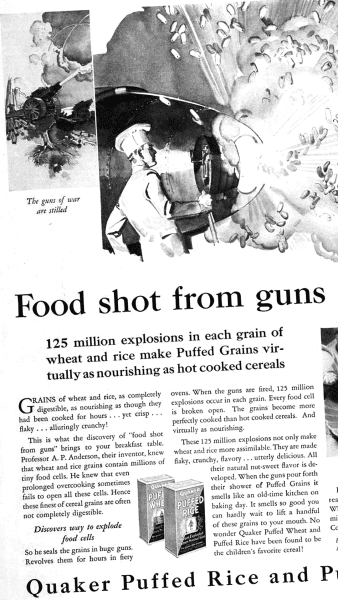
Deep knowledge is the key to selling effectively, says Hopkins, and many hours of painstaking research are usually required to write one good ad. That may include dozens of hours of reading, hundreds of interviews with customers, or thousands of survey letters mailed.
Here are 3 fascinating examples of how deep market research made the difference:
- Selling caffeine-free coffee. After many hours of research, Hopkins uncovered a key medical fact: the “kick” that coffee gives isn’t from the caffeine, which is tasteless and odorless, the kick comes two hours later. This became the cornerstone of a successful campaign.
- Marketing canned pork and beans. This product was initially marketed against the competitors, but their survey found the real problem—that almost nobody buys canned beans! 96% of consumers were baking their own beans at home. Recognizing this, Hopkins quickly pivoted the campaign towards the convenience of canned beans versus home cooking, leading to success.
- Promoting puffed grains. Hopkins studied the manufacturing process of this new food, which revealed an interesting fact, giving birth to the iconic headline “Food shot from guns!”
(Personally, I think that is one of Hopkins’ best. Who wouldn’t want to eat food shot from guns?)
Marketing guru Dan Kennedy also emphasizes the importance of deep customer understanding in his influential book “The Ultimate Sales Letter.” He says the first step of successful copywriting is to get “into” the mind of our target customer, for which he provides 10 practical questions including “What keeps them awake at night?”, “What are they afraid of?” or “angry about?”, “What are their top three daily frustrations?”, and so on.
Stay tuned for our upcoming summary of The Ultimate Sales Letter by Dan Kennedy
Always remember to treat your ad as a salesperson, not an entertainer. Visualize a good salesperson pitching your product to one potential buyer. If they wouldn’t say something to that buyer face-to-face, then it doesn’t belong in your ad! Invest many hours into deep research, so you can uncover facts on which to build a unique marketing campaign.
📊 3. Make Your Claims Specific: People trust hard facts, not boasting or bragging
A common mistake in advertising is the usage of unclear, boastful claims like “best quality” or “world-class.” According to Claude Hopkins, these generic statements make little to no impact on potential customers. Why? Because they EXPECT us to praise the product we’re selling—so they discount any broad statements we make about it as baseless self-promotion. The key is to transform these fuzzy claims into hard, specific facts.
Being specific with your claims will dramatically multiply the effectiveness of each sentence you write. It will add credibility, authority, and trust to your sales messages—because people will actually take your claims seriously! It’s relatively easy to bluff with some vague boast like “highest quality,” but lying about a particular fact is very risky. So when advertisers say something specific, people trust that fact has been measured and proven.
Here are some examples of how to convert broad claims into specific, persuasive facts (the first two from Hopkins’ own ads):
- “Fastest shave” becomes “78-second shave”,
- “Used all over the world” becomes “Used by people in 52 nations”,
- “Our product is long-lasting” becomes “Our product lasts 4 hours longer than our main competitor”,
- “Our coffee tastes great” becomes “Our coffee, sourced from the high-altitude regions of Colombia, is carefully slow-roasted in small batches, to unlock its rich flavours and aromas.”
- “We provide fast delivery” becomes “We guarantee delivery within 48 hours, or your money back.” (Dominoes Pizza became a major brand with a similar promise.)
- “Our fitness app has workout routines for everyone” becomes “Our fitness app features 3,672 different workouts, each designed by certified trainers to target specific muscle groups.”
In Scientific Advertising, Claude Hopkins even talks about how it’s useful to hire chemists (scientists) to measure specific claims, like the number of calories in a food product. Then you can put that scientific fact in your advertising…
I think this idea closely aligns with a principle of persuasion explained by Robert Cialdini in his must-read book Influence. Cialdini emphasizes the concept of “authority” being a critical factor in persuasion—people tend to obey and trust figures of authority. Well, when we provide specific facts, then we position ourselves as an authoritative figure in the field, not just another advertiser bragging about their product.
Beware making vague claims like “highest quality,” which make no impact whatsoever. Instead, transform your claims into hard, specific facts—usually featuring a number that has been measured and proven.
🏷️ 4. How to Name Your Product: One type of name to avoid, and three naming formulas that increase odds of success
The name you choose for your product or business can have a powerful impact on its success. After all, the name is prominently displayed to your customers, it’s often the first thing they see. So we need to make sure to choose a name that resonates with your target customers and clearly communicates your product’s unique selling proposition.
First of all, here’s one type of name you should probably avoid:
- The Generic Name. Choosing a name that exactly describes your product can be appealing, but Hopkins says it risks inviting competitors to come in with “substitution products” that capitalize on the demand you’ve created. Classic examples are “Toasted Corn Flakes” and “Royal Baking Powder,” where pioneering companies built up a demand, only to have competitors rush in and take over the market.
Now here are three types of names that Hopkins does recommend:
- The Storytelling Name. This is a name that tells a story or paints a picture all by itself. Examples from Hopkins’ time include “Cream of Wheat” and “Palmolive Soap.” Today, we have “5-Minute Energy,” “Facebook” and “SpaceX.” These names not only describe the product, they illustrate a unique promise or selling point.
- The Owner’s Name. Using the owner’s name can be very good, say Hopkins, because it demonstrates pride in the creation and gives a human touch to the advertising. Whenever possible, he tries to write advertising as coming from a human being, a personality that is relatable, instead of a “soulless corporation.” Examples include: Ford, Kellogg’s, Ben & Jerrys, and McDonald’s.
- The Coined (Branded) Name. This type of name is based on a word that has no pre-existing meaning, but over time you make people familiar with your brand name. Because you alone own a branded name, nobody else can use it. In come cases, the brand name can become synonymous with the product category, providing a powerful barrier to competition. For example, “Vaseline,” “Jell-O,” and “Kleenex” are all coined/branded names that have stood the test of time.
This echoes a similar concept in the much-recommended book “The 22 Immutable Laws of Marketing,” which discusses the power of owning a word or category in the customer’s mind. Those authors said, “The basic issue in marketing is creating a category you can be first in. It’s the law of leadership: It’s better to be first than it is to be better. It’s much easier to get into the mind first than to try to convince someone you have a better product than the one that did get there first.”
That is why, in so many examples, the first product in a category continues to be the dominant one. The first university in America? Harvard. The first cola drink? Coca-Cola. The first touchscreen phone? iPhone. (Well, technically they were a year late, but they got into people’s minds first, and the authors say that is most important.)
Read more in our summary of The 22 Immutable Laws of Marketing
A name that is too generic like “Toasted Corn Flakes” invites easy competition. Better are storytelling names that paint a picture like “Cream of Wheat,” or branded names that can’t easily be copied like “Kleenex” or even the owner’s personal name like Kellogg’s which is more relatable.
🎁 5. Utilize FREE Samples: Launch a new product or business fast with this powerful marketing strategy
We’re all just humans and let’s face it, when we’re shopping, it’s all about us. We’re not looking to do any business a favour buying their product. Instead, they have to appeal to our self-interest and show us why the product will benefit us, why it’s worth it. So if you want to catch the attention of your potential customers, then you need to recognize that fact, and offer something that adds value to their lives. (Hopkins would say “offer service.”)
The simplest way to do add value? Offer a free sample.
Think about how much more compelling it is to tell a potential buyer, not “buy my product,” but “try it for a week, then decide.”
Your product itself should be your best salesperson, says Hopkins—so it better be good! Back in his day, a business would send out a sewing machine to a house for a week, or a box of oatmeal.

Today we continue to see the same strategy used for some of the largest products like Netflix, Amazon Prime, Spotify, Disney+, and Apple Music. Typically, they offer a 1-month free trial for anyone to try their services. I’ve even seen special promotions offering up to 3 or 4 months free.
An important warning: Don’t give samples away to anyone. Only give samples to people who have shown their interest in your product by some effort, like by bringing in a coupon. The sample must be combined with the right mental impression created by the ad, for them to see the value of your product.
Beyond that, free samples offer additional benefits like:
- Reducing friction for customers. A major part of good selling is making it as easy as possible for customers to get your product. It’s just human nature that we like to take the path of least resistance. Hopkins found that 4X more customers would show a coupon in stores, rather than taking the larger effort of mailing it in. And 70% of customers would call on the phone, when that option was available. So keep making it easier and easier for your customers to respond!
- Achieving wide distribution. In Hopkins’s era, convincing dealers to stock a new product was a significant challenge. By showing them an upcoming ad with a free coupon, each one representing a full-profit sale, dealers become very inclined to stock the product, knowing many people will likely redeem these coupons. And so free samples were the best strategy for many products (like Palmolive soap) to achieve national distribution fast, and that alone made them worth it.
- Lowering advertising costs. Some business people may object to samples, saying “it’s too expensive!” But Hopkins argues that in his experience, the samples pays for themselves because they allow us to use the word “FREE!” in our headlines. That brings in so many more readers and response, that our cost per each reply and cost per customer end up being significantly lower. He also advises against offering a “50% off” deal or “buy one, get one free” promotion, because those only offer a fraction of the power of “FREE.”
100 years after Claude Hopkins wrote those words, we actually have some academic scientific research to back them up. There’s a book called Predictably Irrational, written by the MIT researcher and professor Dan Ariely. He also makes a big point about the power of free—of a price of zero.
In his experiments, he found “Zero is not just another discount. Zero is a different place. The difference between two cents and one cent is small. But the difference between one cent and zero is huge!” Imagine you had 3 different tables offering cookies on 3 different college campuses: One of these tables offered cookies for 2 cents each, another for 1 cent each, and the third table said “FREE Cookies!” Well, that third table would be giving away dramatically more cookies than the other two, even though it’s the same discount between 2 cents and 1 cent, as it is between 1 cent and free. That’s what he means by ‘free is a different place altogether.’
Professor Ariely believes that when something is FREE! then we don’t feel any psychological fear of loss. There’s no risk of making a bad decision, no downside. So that is why people go for what is FREE in a powerful way.
Free samples were, and continue to be, one of the most powerful marketing strategies. Instead of asking people to “buy my product” you’re offering value by saying “try it free, then decide.” Additional benefits of samples include lowering your overall cost of advertising, accelerating distribution, and lowering friction for your customers.
🗣️ 6. Tell More, Sell More: Debunking the common myth that ads need to be short
People will often tell you that ads need to be short and sweet. This myth was as common in the days of Claude Hopkins as it is today.
However, the results from advertising tests usually show that “the more you tell, the more you sell.” If a prospective customer is genuinely interested in buying something—whether it’s a car, a home, or a phone—they may consume pages and pages of information related to that purchase. So we should not be afraid of providing all the information people need to make a buying decision.

Related to this, here are some more points to keep in mind:
- Choose visuals carefully. Pictures should never be used simply to decorate an ad, says Hopkins, because then you’ll just be wasting money and valuable space. Each visual must add to the selling argument more than if that space was used by text. Some good examples: photos work well in clothing and food advertising, or to present an image of what the prospect desires to be using your product—perhaps a successful man or a beautiful woman. (Hey, this book was written in the 1920’s, we should expect some stereotypes!)
- Tell your full story. In other words, include all the appeals that may help to sell your product. If you were selling a toothpaste, your headline may talk about a beautiful smile, and the rest of the ad would include additional benefits like: cleanliness, hygiene, nice breath, etc. Hopkins says that once we have a person’s attention, this will be our one opportunity to sell them, because they will probably not spend time to read out other ads. Therefore, we should tell our full story.
- Study mail order ads. Mail order advertising was the most difficult type to make work. People had to be persuaded to send their payment through the mail for a product they couldn’t see. And because mail order advertising tended to be measured, it provided some of the best lessons for how to sell effectively. One big thing: Using lots of small text to fit in the most amount of words possible. Here’s how we can apply this idea to the current year…
If you’re interested in online business, then you may have heard of Russell Brunson. He co-founded the software company ClickFunnels, which helps business owners build sales funnels online and now does over $100M per year in revenue!
In his extraordinarily useful book Dotcom Secrets, Russell Brunson explains a method called “funnel hacking,” that he follows before creating any new sales funnel. He always starts with examining the websites of several competitors, so he can understand deeply how their business works. He studies every step of their sales funnels, taking screenshots and notes along the way. Later he can use that information to greatly improve his odds of success. (Online sales funnels are basically the modern version of mail order advertising.)
It’s important to note, however, this is NOT about copying other people’s words. Rather, the goal is to study the underlying structure of sales funnels that are already successful, then use those general insights in our own business. (In fact, this strategy is very old! Advertising copywriters like Claude Hopkins have been doing it for decades, keeping a “swipe file” of impressive ads handy for inspiration.)
Learn more in our summary of Dotcom Secrets by Russell Brunson
Many believe ads must be short, but testing proves that “the more you tell, the more you sell.” At least, if someone is really interested in your product. So think twice about pictures used only for decoration, share your product’s “full story” and benefits in every ad, and study effective ads and sales funnels.
🧠 7. The Psychology of Advertising: Key principles that can multiply the effectiveness of your sales messages
Finally, we’ll wrap up with a collection of concepts related to the psychology of writing great ads. These are small tips or hacks that didn’t really fit anywhere else in this summary, but you’ll still find them very useful:
- Curiosity is a powerful trigger. If you can say something unexpected, especially in the headline of your ad, then you’ll capture people’s attention. Like when Claude Hopkins created the headline for a cereal that said: “Grains puffed to 8 times their normal size.”
- Perceived value, not cheapness. Cheapness is not appealing, says Hopkins, because people tend to judge a product’s quality based on the price. What people want are “bargains, but not cheapness.”
- Personalization is powerful. Adding a personal inscription to certain products, like a set of business books, made the product far more successful.
- Urgency and Limited Offers. It always helps to have some reason for the reader to take immediate action, such as an offer available for a limited time or in limited quantities. This combats the natural human tendency to delay.
- Habits are costly to change. In many cases, when we try to change people’s old habits through ads, it is far too costly. Like a toothpaste advertiser found it cost $25 to get a person to begin brushing their teeth. However, what can be very profitable, says Hopkins, is keeping an eye on trends, and offering the right product just as a trend is taking off. Then we are not trying to change people, but going with the direction they are already heading. For example, offering a new and unique type of toothpaste, made with organic ingredients.
This last point reminds me of an idea from the master copywriter Eugene Schwartz, who wrote “Breakthrough Advertising,” considered by many professionals to be the best book ever written on copywriting. Schwartz had a theory of “mass desire,” believing that successful advertising never tries to make people desire something they don’t want, but rather taps into pre-existing desires in the market:
“The power, the force, the overwhelming urge to own that makes advertising work, comes from the market itself, and not from the copy. Copy cannot create desire for a product. It can only take the hopes, dreams, fears and desires that already exist in the hearts of millions of people, and focus those already existing desires onto a particular product. This is the copy writer’s task: not to create this mass desire—but to channel and direct it.”
Learn more in our summary of Breakthrough Advertising (coming in the future)
To writing effective ad copy, it greatly helps to understand human psychology. It’s about strategically leveraging natural human desires—like curiosity, perceived value, personalization, and limited offers. And most of all, we’re just channeling existing mass desires onto our product, not trying to create new desires.
- Create a ‘scientific’ advertising test. (This step applies if you already have some kind of business website.) There are many apps and tools available now that make it easy for us to test one type of sales page against another, one type of email against another, one type of popup against another. These are often called “A/B” or “split” testing tools. For example, here’s a list of 10 plugins that do this for WordPress, the most popular website software.
- Write for ONE person. When you write your sales message, imagine you’re talking to just ONE potential customer. This makes your writing clear and direct. Picture what a good salesperson would say to them about your product in person and then write that down, avoiding any pointless slogans, entertainment, or fluff.
- Offer free samples or trials. What can you give potential customers, that has genuine value and helps them experience the value of your product? This strategy may appear to cost money, but it often does the opposite by lowering our advertising costs and removing friction from the buying process. That’s why free samples were an essential part of so many of Hopkins’ campaigns.

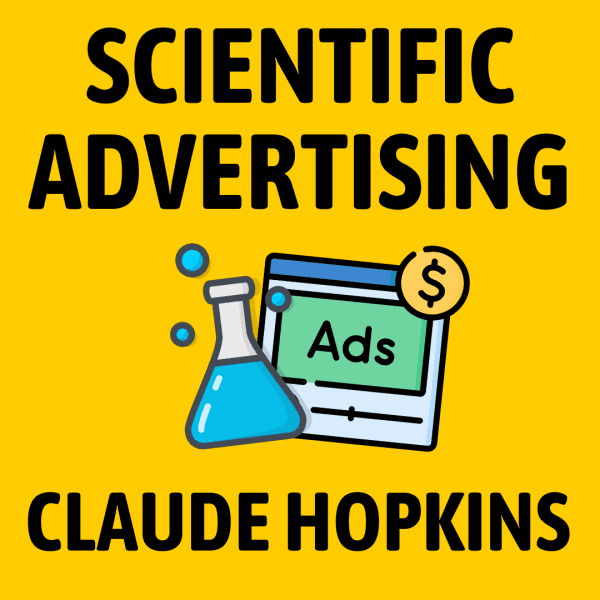
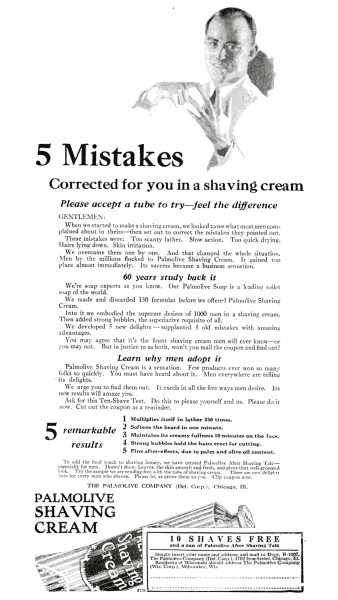

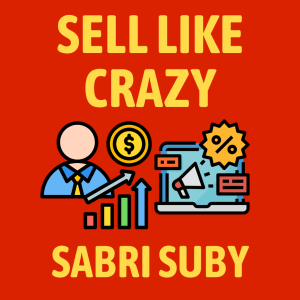










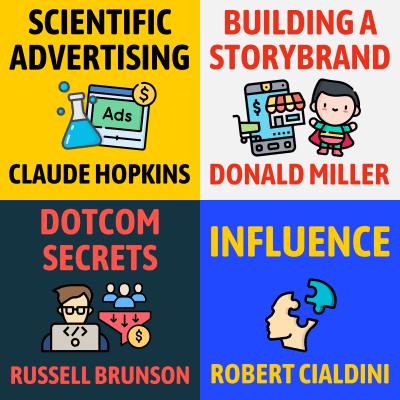
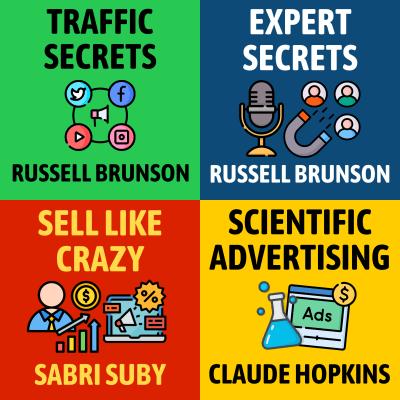











Community Notes